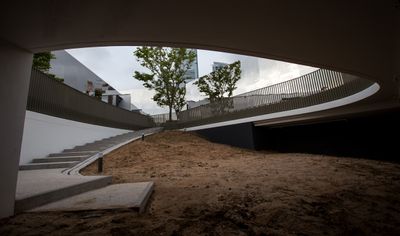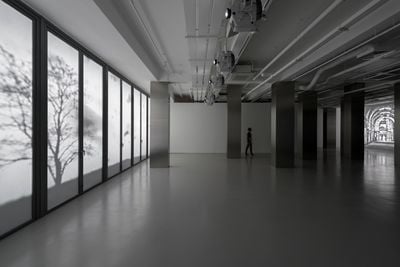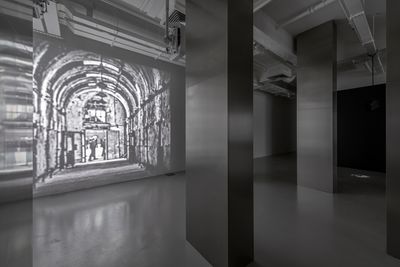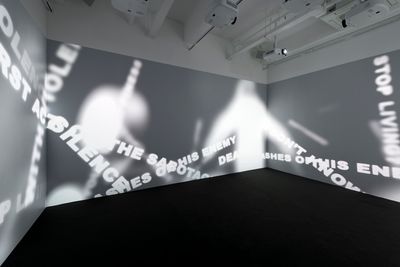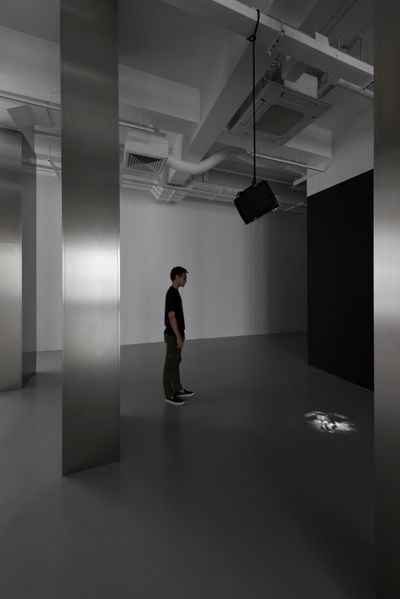Nothing: Tsang Kin-wah at M+ Pavilion, Hong Kong

Tsang Kin-Wah. Courtesy of the artist
Tsang Kin Wah: Nothing, the inaugural show at M+ Pavilion, constructed to hold exhibitions and events before the main museum's opening in 2019, launched to a surprisingly quiet audience. Unlike M+'s previous shows there was no harsh criticism from a local community that has challenged M+ at every turn—with issues ranging from who is hired and what is shown—given the museum's role in the Hong Kong government's West Kowloon Cultural District project. Perhaps the success of Lee Kit's M+-organised Venice Biennale exhibition in 2013 quieted the naysayers, or Hong Kong since the Umbrella Movement is now facing more urgent political issues. Or perhaps we are finally ready to turn our attention to the art.
Nothing was the follow-up to Tsang's 56th Venice Biennale presentation, The Infinite Nothing (9 May — 22 November, 2015), for which the artist created a cavernous underwater space befitting of the city of canals in four rooms of Campo della Tana. The first room had beams of slightly blurred and rapid water movement projected on the floor, while in the others, the sounds of dripping water and falling rain continued the theme. The otherworldly sensation of aquatic submersion allowed Tsang to explore existential questions of why and how we live, mixed with angry challenges to the Christian faith—a stance not untypical of a former Christian. Tsang did this by projecting biblical phrases, philosophical texts and cultural idioms across the four rooms. In the final room, where empty niches suggested an ecclesiastic environment, a classical score descended to cacophonic noise as phrases such as 'HOPE WITHOUT THE ABYSS,' 'NO END', and 'THE IGNORANCE OF TRUTH' spun across the space. However, the ultimate citation underpinning the exhibition was Friedrich Nietzsche's 'Parable of a Madman' (1882) in which a wanderer announced the death of God to a village, proclaiming, 'Are we not straying as through an infinite nothing? Do we not feel the breath of empty space?'
While in his Venice Biennale exhibition, Tsang invited viewers into an environment that invoked the feeling of being underwater, in Hong Kong, the artist went aboveground at the new M+ Pavilion, with five carefully orchestrated installations. Four of these were situated inside in an open-plan indoor space, and cleverly arranged so as to flow into one another, while the other existed outside in relation to the pavilion's architecture. The title of the exhibition, Nothing, expanded on the theme the artist tackled in Venice by creating a double-negation. In modern usage, a strikethrough is used to delete text, but retains the original word as an act of transparency. In this way, it can take on an ironic function, showing the writer's self-awareness of his writing.
As in Venice, Tsang used one distinctive motif that is repeated in various forms across the show. The tree, here used as a metaphor for imprisonment and death, appeared throughout the M+ Pavilion's unusual architectural space. The two-storey building cantilevers out of a hillside, with an outdoor balcony lined with mirrors on the second floor where Tsang's exhibition was staged. The large, looping balcony encircles a grass area with a manmade mound below. On top of this hill is a single tree with slender branches stretching tall enough to be seen from the balcony. According to the pavilion's designers; VPANG architects ltd, JET Architecture Inc and Lisa Cheung, the mirrored walls were constructed to reflect the greenery of the space, making the building appear as if it 'floats above the foliage'. To access Tsang's show, visitors climbed the winding staircase that leads to the outdoor balcony where swirls of phrases such as, 'THERE WAS A PAUSE', 'I START TO CRY', and 'IN THE BEGINNING' snaked around the balcony's concrete floor in dark grey vinyl.
Over the balcony's edge, the lawn was activated with a discreet intervention. Below, Tsang broke up the greenery surrounding the single tree into broken clods of brown earth. The tree appeared multiplied by the balcony's mirrored walls, which also caught reflections of the surrounding landscape of cranes and skyscrapers. Suddenly, it was difficult to tell where the sky ends and the walls meet, recalling the title of Tsang's Venice Biennale presentation and the power of the infinite. Meanwhile, what was the distinctive shape of the Kowloon landscape was now refracted by the angled mirrors that clad the pavilions walls, while the tree stood complete. Tsang's was a subtle intervention of simply churning the ground into earthen clods was strangely affective due to the fragmentation of what is normally a manicured plot of greenery. In conversation, Tsang said he was thinking about loneliness and destruction when he was working on the piece, but the symbolism of the tree's completeness amongst chaos was of unwavering strength.
As soon as one entered the darkened gallery, one was confronted with a multimedia work featuring a projected image of a gothic prison with inmates walking in endless circles. The soundtrack of Stanley Kubrick's Clockwork Orange (1971) was audible, but none of the menace of the original film was present. The inmates' circling was hypnotic, and mirrored the timelessness represented by the imposing prison architecture. Tsang had cleverly crafted a path to lead viewers to the next installation by adding ten floor-to-ceiling columns wrapped in aluminum plates to an existing set of four structural columns (similarly wrapped), and arranging these in a manner so that visitors were made to walk through them before reaching the next installation. The columns evoked both metallic prison cell bars and trees in a forest. Walking through, the lighting gradually darkened in anticipation of the next installation. Here, Tsang covered up the space's original wall of windows to cast his projection of a silhouette image of a tree and falling leaves. This digitised tree echoed the one outside, but if the real object exuded strength, this tree represented autumnal death. The work recalls Tsang's reference in this show to Aokigahara, a forest near Mount Fuji, also known as 'The Sea of Trees' and more infamously as 'Suicide Forest'. (The site's more sensationalised reputation has made it the subject of many creative projects including films, novels, and now this artwork.) However, the emotional extremity of suicide was flattened by the more sentimental visual effect of the dying tree, with the literalness of the theme lacking bite.
The installation that followed was presented in an enclosed box space within the gallery. In this room, phrases such as 'SILENCE HERE I AM' and 'AGONY RIGHT HERE'—borrowed from Kurt Cobain songs, adding a punk edge to Tsang's usual penchant for philosophy—was projected onto the walls. These phrases undulated to a soundtrack that began with Beethoven and ended with Kurt Cobain, with words eventually merging into shapeless blobs reminiscent of those found in lava lamps. The sense in here, amplified by the loud grunge rock and the blurry blobs of words, was almost psychedelic, as if it were a digitalised version of a drug trip with Cobain himself, who famously killed himself because of his depression. Beyond this was the final installation: a small disc-shaped projection on the floor that, as with the tree at the entrance, was almost too easy to miss. A time-based projection that slowly faded in and out, it presented a compressed image of a donkey with his head low to the ground and shown slightly at an angle, which could be made out at certain times and positions (viewers had to walk around the disc). When the image came into view, a sense of ludicrousness to the picture unfolded: why did the donkey appear squished and why was he bowing? Eventually, a rope around the donkey's neck became visible—a sign of having reached an end. There was a dark humour to this projection, which may not have been wholly Tsang's intention, though the finality of its symbolism was. Given how taboo the subject of suicide still is in a region that has nevertheless been affected by high suicide rates among young adults and children in the recent past, some nudging from the curatorial team led Tsang to alter the angle of the project so that the image of the donkey became awkwardly squished. The result, whether by design or not, felt at once ridiculous (as the image of a bowing donkey can feel), and guilt-inducing, as viewers realised what they were looking at was a dying beast. This was far more effective as an absurdist conclusion to an impossible infinity—a nothing where death looks silly.
It was in this last work that one began to see the shadow of filmmaker Gus Van Sant. Beethoven's Moonlight Sonata is used in the soundtrack for Van Sant's film Elephant (2003), and Kurt Cobain's music in the soundtrack for Last Days (2005). The trees also reference Van Sant's movie The Sea of Trees (2015), while Kubrick's Clockwork Orange is much loved by the American moviemaker. But Tsang's Nothing was by no means an homage to Van Sant. Simply, his films offered a source that resonated with the artist's thoughts about existence. In this regard, while the show began with an exhibition text quoting Shakespeare's Macbeth, the words of the independent filmmaker also ring true: 'Even when you're making a movie about life, death is a presence, and I guess it is part of my dramatic viewpoint.' This may have been a show about death, but life will always be a presence, whether it appears in the form of a donkey or a tree.—[O]

